- Home
- Thomas Harris
Red Dragon hl-1 Page 9
Red Dragon hl-1 Read online
Page 9
Facing the Jacobi house across the road was the single entrance to Stonebridge. The sign said that Stonebridge had a private patrol service. A strange vehicle would be noticed there. So would a man walking late at night. Scratch parking in Stonebridge.
Graham went back into the house and was surprised to find the telephone working. He called the Weather Bureau and learned that three inches of rain fell on the day before the Jacobis were killed. The ditches were full, then. The Tooth Fairy did not hide his vehicle beside the asphalt road.
A horse in the pasture beside the yard kept pace with Graham as he walked along the whitewashed fence toward the rear of the property. He gave the horse a Life-Saver and left him at the corner as he turned along the back fence behind the outbuildings.
He stopped when he saw the depression in the ground where the Jacobi children had buried their cat Thinking about it in theAtlantapolice station withSpringfield, he had pictured the outbuildings as white. Actually they were dark green.
The children had wrapped the cat in a dish towel and buried it in a shoebox with a flower between its paws.
Graham rested his forearm on top of the fence and leaned his forehead against it.
A pet funeral, solemn rite of childhood. Parents going back into the house, ashamed to pray. The children looking at one another, discovering new nerves in the place loss pierces. One bows her head, then they all do, the shovel taller than any of them. Afterward a discussion of whether or not the cat is in heaven with God and Jesus, and the children don’t shout for a while.
A certainty came to Graham as he stood, sun hot on the back of his neck: as surely as the Tooth Fairy killed the cat, he had watched the children bury it. He had to see that if he possibly could.
He did not make two trips out here, one to kill the cat and the second for the Jacobis. He came and killed the cat and waited for the children to find it.
There was no way to determine exactly where the children found the cat. The police had located no one who spoke to the Jacobis after noon, ten hours or so before they died.
How had the Tooth Fairy come, and where had he waited?
Behind the back fence the brush began, running head-high for thirty yards to the trees. Graham dug his wrinkled map out of his back pocket and spread it on the fence. It showed an unbroken strip of woods a quarter-mile deep running across the back of the Jacobi property and continuing in both directions. Beyond the woods, bounding them on the south, was a section line road that paralleled the one in front of the Jacobi house.
Graham drove from the house back to the highway, measuring the distance on his odometer. He went south on the highway and turned onto the section line road he had seen on the map. Measuring again, he drove slowly along it until the odometer showed him he was behind the Jacobi house on the other side of the woods.
Here the pavement ended at a low-income housing project so new it did not show on his map. He pulled into the parking lot. Most of the cars were old and sagging on their springs. Two were up on blocks.
Black children played basketball on the bare earth around a single netless goal. Graham sat on his fender to watch the game for a moment.
He wanted to take off his jacket, but he knew the .44 Special and the flat camera on his belt would attract attention. He always felt a curious embarrassment when people looked at his pistol.
There were eight players on the team wearing shirts. The skins had eleven, all playing at once. Refereeing was by acclamation.
A small skin, shoved down in the rebounding, stalked home mad. He came back fortified with a cookie and dived into the pack again.
The yelling and the thump of the ball lifted Graham’s spirits.
One goal, one basketball. It struck him again how many things the Leedses had. The Jacobis too, according to the Birmingham police when they ruled out burglary. Boats and sporting equipment, camping equipment, cameras and guns and rods. It was another thing the families had in common.
And with the thought of the Leedses and the Jacobis alive came the thought of how they were afterward, and Graham couldn’t watch basketball anymore. He took a deep breath and headed for the dark woods across the road.
The underbrush,heavy at the edge of the pine woods, thinned when Graham reached the deep shade and he had easy going over the pine needles. The air was warm and still. Blue jays in the trees ahead announced his coming.
The ground sloped gently to a dry streambed where a few cypresses grew and the tracks of raccoons and field mice were pressed into the red clay. A number of human footprints marked the streambed, some of them left by children. All were caved in and rounded, left several rains ago.
Past the streambed the land rose again, changing to sandy loam that supported ferns beneath the pines. Graham worked his way uphill in the heat until he saw the light beneath the trees at the edge of the woods.
Between the trunks he could see the upper story of the Jacobi house.
Undergrowth again, head-high from the edge of the woods to theJacobis’ back fence. Graham worked his way through it and stood at the fence looking into the yard.
The Tooth Fairy could have parked at the housing development and come through the woods to the brush behind the house. He could have lured the cat into the brush and choked it, the body limp in one hand as he crawled on his knees and other hand to the fence.Graham could see the cat in the air, never twisting to land on its feet, but hitting on its back with a thump in the yard.
The Tooth Fairy did that in daylight—the children would not have found or buried the cat at night.
And he waited to see them find it. Did he wait for the rest of the day in the heat of the underbrush? At the fence he would be visible through the rails. In order to see the yard from farther back in the brush, he would have to stand and face the windows of the house with the sun beating on him. Clearly he would go back to the trees. So did Graham.
TheBirminghampolice were not stupid. He could see where they had pushed through the brush, searching the area as a matter of course. But that was before the cat was found. They were looking for clues, dropped objects, tracks—not for a vantage point.
He went a few yards into the forest behind the Jacobi house and worked back and forth in the dappled shade. First he took the high ground that afforded a partial view of the yard and then worked his way down the tree line.
He had searched for more than an hour when a wink of light from the ground caught his eye. He lost it, found it again. It was the ring-pull tab from a soft-drink can half-buried in the leaves beneath an elm tree, one of the few elms among the pines.
He spotted it from eight feet away and went no closer for five minutes while he scanned the ground around the tree. He squatted and brushed the leaves away ahead of him as he approached the tree, duck-walking in the path he made to avoid ruining any impressions. Working slowly, he cleared the leaves all around the trunk. No footprints had pressed through the mat of last year’s leaves.
Near the aluminum tab he found a dried apple core eaten thin by ants. Birds had pecked out the seeds. He studied the ground for ten more minutes. Finally he sat on the ground, stretched out his aching legs, and leaned back against the tree.
A cone of gnats swarmed in a column of sunlight. A caterpillar rippled along the underside of a leaf.
There was a wedge of red creek mud from the instep of a boot on the limb above his head.
Graham hung his coat on a branch and began to climb carefully on the opposite side of the tree, peering around the trunk at the limbs above the wedge of mud. At thirty feet be looked around the trunk, and there was the Jacobi house175yards away. It looked different from this height, the roof color dominant. He could see the backyard and the ground behind the outbuildings very well. A decent pair of field glasses would pick up the expression on a face easily at this distance.
Graham could hear traffic in the distance, and far away he heard a beagle on a case. A cicada started its numbing bandsaw buzz and drowned out the other sounds.
A thick limb just above hi
m joined the trunk at a right angle to the Jacobi house. He pulled himself up until he could see, and leaned around the trunk to look at it.
Close by his cheek a soft-drink can was wedged between the limb and the trunk.
“Ilove it,” Graham whispered into the bark. “Oh sweet Jesus yes. Come on, can.”
Still, a child might have left it.
He climbed higher on his side of the tree, dicey work on small branches, and moved around until he could look down on the biglimb.
A patch of outer bark on the upper side of the limb was shaved away, leaving a field of green inner bark the size of a playing card. Centered in the green rectangle, carved through to the white wood,Graham saw this:
It was done carefully and cleanly with a very sharp knife. It was not the work of a child.
Graham photographed the mark, carefully bracketing his exposures.
The view from the big limb was good, and it had been improved: the stub of a small branch jutted down from the limb above. It had been clipped off to clear the view. The fibers were compressed and the end slightly flattened in the cutting.
Graham looked for the severed branch. If it had been on the ground, he would have seen it. There, tangled in the limbs below, brown withered leaves amid the green foliage.
The laboratory would need both sides of the cut in order to measure the pitch of the cutting edges. That meant coming back here with a saw. He made several photographs of the stub. All the while he mumbled to himself.
I think that after you killed the cat and threw it into the yard, my man, you climbed up here and waited. I think you watched the children and passed the time whittling and dreaming. When nightcame, you saw them passing their bright windows and you watched the shades go down, and you saw the lights go out one by one. And after a whileyou climbeddownand went in to them. Didn’t you? Itwouldn’t be too hard a climb straight down ftom the big limb with a flashlight and the bright moon rising.
It was a hard enough climb for Graham. He stuck a twig into the opening of the soft-drink can, gently lifted it from the crotch of the tree, and descended, holding the twig in his teeth when he had to use both hands.
Back at the housing project, Graham found that someone had written “Levon is a doo-doo head” in the dust on the side of his car. The height of the writing indicated that even the youngest residents were well along in literacy.
He wondered if they had written on the Tooth Fairy’s car.
Graham sat for a few minutes looking up at the rows of windows. There appeared to be about a hundred units. It was possible that someone might remember a white stranger in the parking lot late at night. Even though a month had passed, it was well worth trying. To ask every resident, and get it done quickly, he would need the help of theBirminghampolice.
He fought the temptation to send the drink can straight to Jimmy Price inWashington. He had to ask theBirminghampolice for manpower. It would be better to give them what he had. Dusting the can would be a straightforward job. Trying for fingerprints etched by acid sweat was another matter. Price could still do it afterBirminghamdusted, as long as the can wasn’t handled with bare fingers. Better give it to the police. He knew the FBI document section would fall on the carving like a rabid mongoose. Pictures of that for everybody, nothing lost there.
He called Birmingham Homicide from the Jacobi house. The detectives arrived just as the realtor, Geehan, was ushering in his prospective buyers.
Chapter 11
Eileen was reading a National Tattler article called “Filth in Your Bread!” when Dolarhyde came into the cafeteria. She had eaten only the filling in her tuna-salad sandwich.
Behind the red goggles Dolarhyde’s eyes zigged down the ftont page of the Tattler. Cover lines in addition to “Filth in Your Bread!” included “Elvis at Secret Love Retreat—Exclusive Pix!!” “Stunning Breakthrough for Cancer Victims!” and the big banner line “Hannibalthe Cannibal Helps Lawmen—Cops Consult Fiend in ‘Tooth Fairy’ Murders.”
He stood at the window absently stirring his coffee until he heard Eileen get up. She dumped her tray in the trash container and was about to throw in the Tattler when Dolarhyde touched her shoulder.
“May I have that paper, Eileen?”
“Sure, Mr. D. I just get it for the horoscopes.”
Dolarhyde read it in his office with the door closed.
Freddy Lounds had two bylines in the same double-page center spread. The main story was a breathless reconstruction of the Jacobi andLeedsmurders. Since the police had not divulged many of the specifics,Lounds consulted his imagination for lurid details. Dolarhyde found them banal.
The sidebar was more interesting:
Insane Fiend Consulted in Mass Murders
by Cop He Tried to Kill
by Freddy Lounds
CHESAPEAKE,MD.—Federal manhunters, stymied in their search for the “Tooth Fairy,” psychopathic slayer of entire families inBirminghamandAtlanta, have turned to the most savage killer in captivity for help.
Dr. Hannibal Lecter, whose unspeakable practices were reported in these pages three years ago, was consulted this week in his maximum-security-asylum cell by ace investigator William (Will) Graham.
Graham suffered a near-fatal slashing at Lecter’s hands when he unmasked the mass murderer.
He was brought back from early retirement to spearhead the hunt for the “Tooth Fairy.”
What went on in this bizarre meeting of two mortal enemies? What was Graham after?
“It takes one to catch one,” a high federal official told this reporter. He was referring to Lecter, known as “Hannibalthe Cannibal,” who is both a psychiatrist and a mass murderer.
OR WAS HE REFERRING TO GRAHAM???
The Tattler has learned that Graham, former instructor in forensics at theFBIAcademyinQuantico,Va., was once confined to a mental institution for a period of four weeks.
Federal officials refused to say why they placed a man with a history of mental instability at the forefront of a desperate manhunt.
The nature of Graham’s mental problem was not revealed, but one former psychiatric worker called it “deep depression.”
Garmon Evans, a paraprofessional formerly employed atBethesdaNavalHospital, said Graham was admitted to the psychiatric wing soon after he killed Garrett Jacob Hobbs, the “Minnesota Shrike.” Graham shotHobbsto death in 1975, endingHobbs’s eight-month reign of terror inMinneapolis.
Evans said Graham was withdrawn and refused to eat or speak during the first weeks of his stay.
Graham has never been an FBI agent. Veteran observers attribute this to the Bureau’s strict screening procedures, designed to detect instability.
Federal sources would reveal only that Graham originally worked in the FBI crime laboratory and was assigned teaching duties at theFBIAcademyafter outstanding work both in the laboratory and in the field, where he served as a “special investigator.”
The Tattler learned that before his federal service, Graham was in the homicide division of theNew Orleanspolice department, a post he left to attend graduate school in forensics atGeorgeWashingtonUniversity.
OneNew Orleansofficer who served with Graham commented, “Well, you can call him retired, but the feds like to know be’s around. It’s like having a king snake under the house. They may not see him much, but it’s nice to know he’s there to eat the moccasins.
Dr. Lecter is confined for the rest of his life. If he is ever declared sane, he will have to stand trial on nine counts of first-degree murder.
Lecter’s attorney says the mass murderer spends his time writing useful articles for the scientific journals and has an “ongoing dialogue” by mall with some of the most respected figures in psychiatry.
Dolarhyde stopped reading and looked at the pictures. There were two of them above the sidebar. One showed Lecter pinned against the side of a state trooper’s car. The other was the picture of Will Graham taken by Freddy Lounds outside theChesapeakeStateHospital. A small photograph o
f Lounds ran beside each of his bylines.
Dolarhyde looked at the pictures for a long time. He ran the tip of his forefinger over them slowly, back and forth, his touch exquisitely sensitive to the rough newsprint. Ink left a smudge on his fingertip. He wet the smudge with his tongue and wiped it off on a Kleenex. Then he cut out the sidebar and put it in his pocket.
* * *
On his way home from the plant, Dolarhyde bought toilet paper of the quick-dissolving kind used in boats and campers, and a nasal inhaler.
He felt good despite his hay fever; like many people who have undergone extensive rhinoplasty, Dolarhyde had no hair in his nose and hay fever plagued him. So did upper respiratory infections.
When a stalled truck held him up for ten minutes on the Missouri River bridge toSt. Charles, he sat patiently. His black van was carpeted, cool and quiet. Handel’s Water Music played on the stereo.
He rippled his fingers on the steering wheel in time with the music and dabbed at his nose.
Two women in a convertible were in the lane beside him. They wore shorts and blouses tied across the midriff. Dolarhyde looked down into the convertible from his van. They seemed tired and bored squinting into the lowering sun. The woman on the passenger side had her head against the seat back and her feet on the dash. Her slumped posture made two creases across her bare stomach. Dolarhyde could see a suck mark on the inside of her thigh. She caught him looking, sat up and crossed her legs. He saw weary distaste in her face.
She said something to the woman at the wheel. Both looked straight ahead. He knew they were talking about him. He was so glad it did not make him angry. Few things made him angry anymore. He knew that he was developing a becoming dignity.
The music was very pleasant.
The traffic in front of Dolarhyde began to move. The lane beside him was still stalled. He looked forward to getting home. He tapped the wheel in time with the music and rolled down the window with his other hand.

 The Silence of the Lambs
The Silence of the Lambs Red Dragon
Red Dragon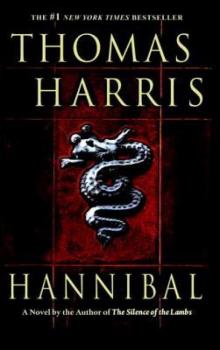 Hannibal
Hannibal Black Sunday
Black Sunday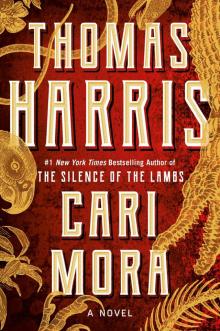 Cari Mora
Cari Mora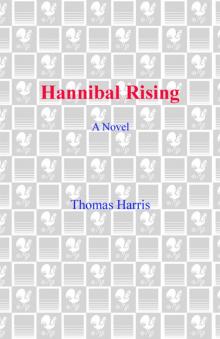 Hannibal Rising
Hannibal Rising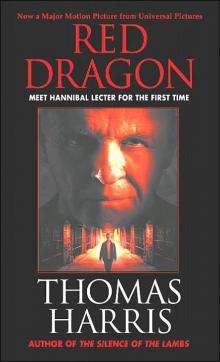 Red Dragon hl-1
Red Dragon hl-1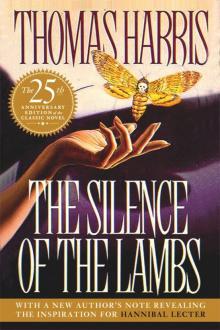 The Silence of the Lambs (Hannibal Lecter)
The Silence of the Lambs (Hannibal Lecter)